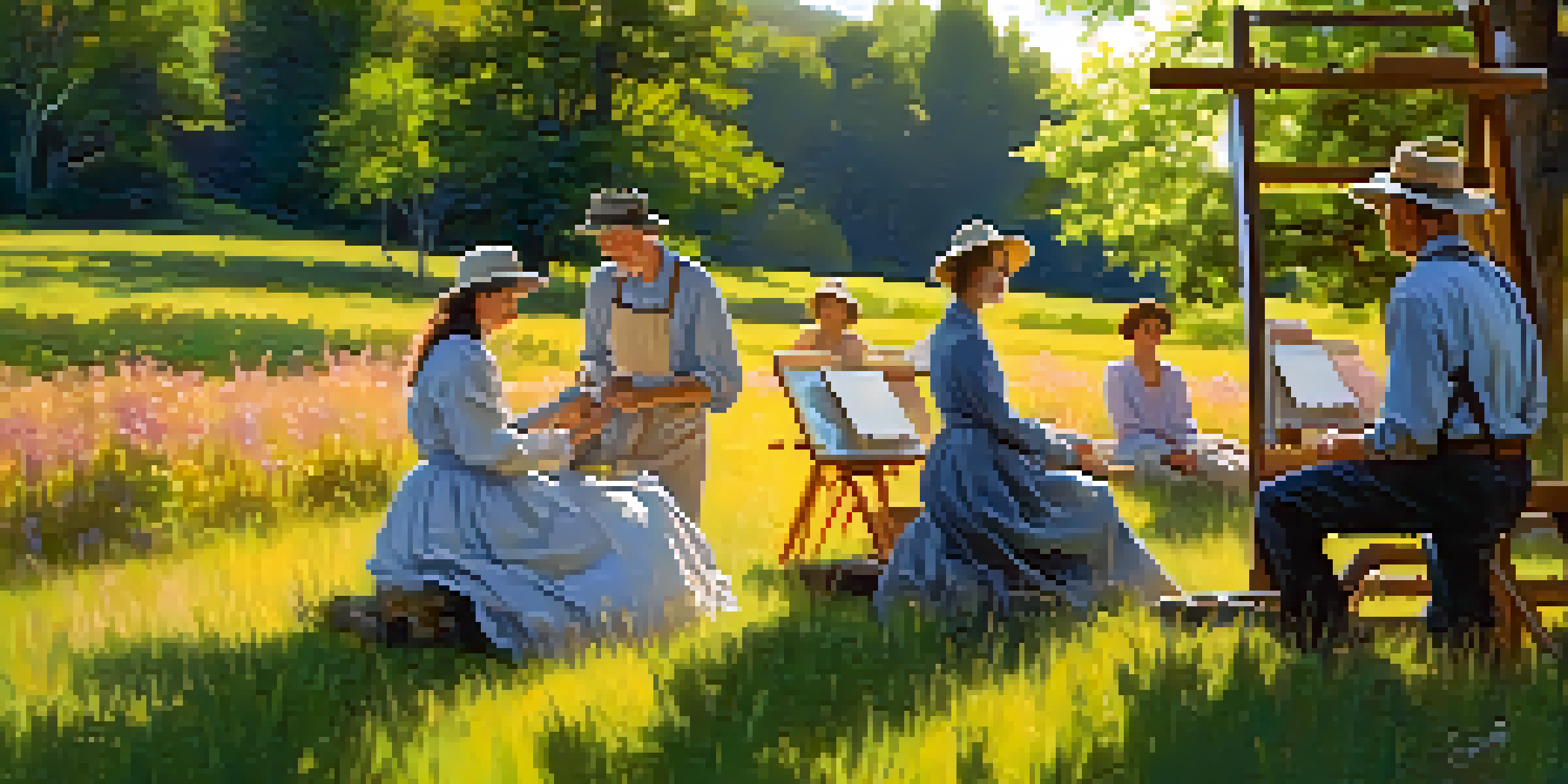Impressionism's Impact on American Art: A Historical Overview

Understanding Impressionism: A Quick Overview
Impressionism emerged in the late 19th century, primarily in France, as artists sought to capture the momentary effects of light and color. This movement broke away from traditional techniques, focusing instead on everyday life and the beauty found in fleeting moments. Artists like Claude Monet and Edgar Degas led the charge, using loose brushwork and vibrant palettes to evoke emotion and atmosphere.
Impressionism is not a movement but a way of seeing.
The term 'Impressionism' itself was derived from Monet's painting 'Impression, Sunrise,' which sparked both admiration and controversy. Critics at the time saw the loose brush strokes as unfinished, yet this style resonated with many artists seeking to explore new forms of expression. The movement emphasized personal experience and perception over realism, encouraging artists to interpret the world through their unique lenses.
As Impressionism gained momentum in Europe, its influence began to cross the Atlantic, igniting a passion for this innovative approach among American artists. The movement's focus on modern life and the natural world inspired a generation of American painters to break free from European academic constraints and explore their own artistic identities.
The First Wave: American Impressionists
In the late 19th century, American artists began to adopt Impressionist techniques, leading to the emergence of a distinct group known as American Impressionists. Artists like Childe Hassam and John Henry Twachtman embraced the movement's principles, focusing on light, color, and everyday subjects. Their work often depicted scenes of nature, urban life, and intimate moments, reflecting the changing American landscape.

These American artists traveled to France to study the masters and returned with fresh ideas that they infused into their own work. They also established art colonies, such as the one in Old Lyme, Connecticut, where they could create and collaborate. This camaraderie fostered a unique blend of European influence and American themes, setting the stage for a new artistic dialogue.
Impressionism's Roots in France
Emerging in the late 19th century, Impressionism focused on capturing light and everyday moments, led by artists like Monet and Degas.
As they painted en plein air (in the open air), these artists captured the essence of American life in a way that resonated with viewers. The vibrant colors and dynamic compositions of American Impressionists marked a significant departure from the more conservative styles that preceded them, paving the way for modern art in the United States.
The Role of Women in American Impressionism
Women played a crucial role in the American Impressionism movement, contributing significantly to its development and recognition. Artists like Mary Cassatt and Childe Hassam's female contemporaries brought a unique perspective to the movement, often focusing on domestic scenes and the lives of women. Their work not only showcased the beauty of everyday life but also challenged traditional gender roles in the art world.
The painter should not paint what he sees, but what will be seen.
Mary Cassatt, in particular, became known for her intimate portrayals of mothers and children, using Impressionist techniques to convey emotion and tenderness. Her success in a male-dominated field inspired other women artists to pursue their passions despite societal constraints. This emphasis on female experiences enriched the broader narrative of Impressionism, highlighting the diversity within the movement.
The work of these women helped to elevate the status of female artists, both in the Impressionist movement and beyond. Their contributions laid the groundwork for future generations of women in art, proving that talent and vision know no gender boundaries.
Impressionism's Influence on American Regionalism
As American Impressionism flourished, it naturally paved the way for subsequent movements, including American Regionalism. This art movement, which emerged in the 1930s, emphasized rural life and regional themes, often portraying the everyday experiences of Americans. Artists like Grant Wood and Thomas Hart Benton took cues from the Impressionist focus on light and color while addressing more localized subjects.
American Regionalists sought to depict the beauty of small-town life and the unique cultural landscapes of the United States. Their work often featured dynamic compositions and bold colors reminiscent of Impressionism, yet they added a layer of narrative that spoke to the American experience. This blending of styles created a rich tapestry of art that reflected both the nation's diversity and its shared values.
American Artists Embrace Impressionism
American Impressionists adopted European techniques, creating a unique blend of style that reflected the changing American landscape.
The impact of Impressionism on American Regionalism illustrated how one movement could inspire another, demonstrating the fluid nature of artistic expression. As artists embraced the principles of Impressionism, they adapted them to tell uniquely American stories, creating a lasting legacy that resonated with audiences.
The Shift Toward Modernism: A New Direction
As the 20th century approached, American artists began to explore new avenues of expression, influenced by the core ideas of Impressionism but also seeking to break free from its confines. The rise of Modernism brought about a wave of experimentation, with artists reinterpreting the principles of light, color, and form. Movements like Abstract Expressionism emerged, transforming the art landscape once again.
Artists such as Jackson Pollock and Georgia O'Keeffe pushed boundaries by moving away from representational art, instead favoring abstraction and emotional intensity. While the brushwork of Impressionism remained relevant, these artists sought to convey their inner experiences rather than merely capturing external scenes. This evolution showcased the versatility of Impressionism as a foundational influence on American art.
The shift toward Modernism marked not an end but a transformation of Impressionism's legacy. It laid the groundwork for future explorations of identity, culture, and emotion, proving that art is an ever-evolving conversation that builds upon the past while embracing the future.
Impressionism's Lasting Legacy in Contemporary Art
Today, the influence of Impressionism can still be felt in contemporary art, shaping the way artists approach their craft. Many modern artists draw inspiration from the movement's emphasis on light, color, and individual perception, incorporating these elements into their own styles and themes. This ongoing dialogue reflects the enduring power of Impressionism as a catalyst for creative expression.
Contemporary artists often explore the boundaries of Impressionism, merging it with other styles and techniques. For instance, some may blend Impressionist brushwork with digital media, creating a unique fusion that resonates with today’s audiences. This adaptability speaks to the movement's core principles, inviting artists to reinterpret and innovate.
Women Artists Shaped the Movement
Women like Mary Cassatt played a crucial role in American Impressionism, challenging traditional norms through their focus on domestic and intimate themes.
Moreover, Impressionism's focus on capturing the essence of a moment continues to inspire artists to engage with their surroundings. Whether through painting, photography, or mixed media, the quest to convey fleeting experiences remains central to many artists' work, ensuring that Impressionism's legacy will persist in the art world for years to come.
Conclusion: Reflection on Impressionism's Impact
The impact of Impressionism on American art is profound and multifaceted, shaping not only the techniques and styles of countless artists but also the very narrative of art history in the United States. From the emergence of American Impressionists to the rise of Regionalism and Modernism, this movement has woven itself into the fabric of American culture. Its emphasis on personal experience, emotion, and the beauty of everyday life continues to resonate.
As we reflect on the influence of Impressionism, it is essential to recognize the diverse voices and perspectives that have shaped its legacy. The contributions of women artists, the evolution into new movements, and the ongoing relevance in contemporary art all highlight the movement's complexity and depth. Impressionism has not only enriched American art but has also transformed how we perceive and interact with the world around us.

In celebrating Impressionism's impact, we honor the artists who dared to see the world differently and inspire future generations to continue this legacy of innovation and exploration. The conversation around art is ever-changing, but the heart of Impressionism—its celebration of light, color, and life—will forever remain a guiding force in the artistic journey.